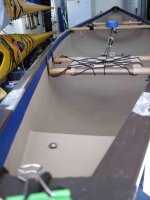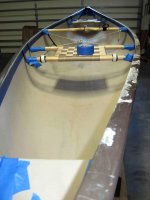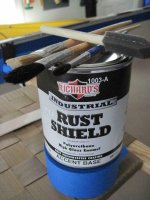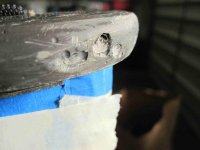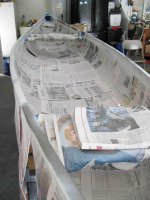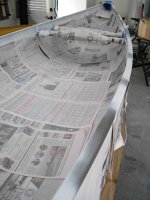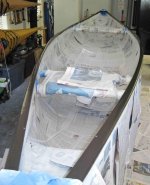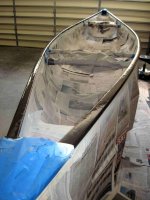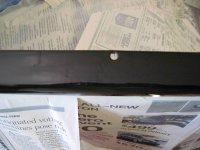Well, sage advice it was when this was offered to me
" That would make me suspect of every other seat hanger rivet at the least.......".
Trusting that the canoe would hold together for one for more trip before the replacement ash seats, yoke, and handles arrived, I took it north with me to run the middle Potomac. Lets see how this thing handles some quick water.
About mid way on a 10 mile trip, while double blading with vigor, I heard a large pop and felt a slight downward fall of the seat. Sensing I was now on borrowed good fortune, I downshifted into a more temperate pace the rest of the way, hoping the seat would last the rest of the way.
Alas, the canoe held up until about 3/4 of mile before the take out when two more loud pops were heard and the seat on one side fell to the floor. The rivets had broken away on both hangers on the right side. In minor counterpoint, the center thwart cracked noisily as one rotten end of the thwart fell to the floor as well. To no surprise, on the same side as the broken away seat. Now the only thing holding the hull in shape besides the deck plates and the remaining seat are the two new handles I installed before I left on my travels.
So the last 3/4 mile was paddled kneeling and I was quite grateful I had on my wrestling knee pads.
So, canoe repair was in order.
First order of business drill out and replace all seat hanger rivets. I finish this task of 14 rivets. Pause and reconsider.....hmmmmm.....that's an ugly looking rivet just holding the gunwale in place. And he has cousins along that side.


One of my old sayings is "the hardest part of a canoe job is getting the canoe on the saw horse" and here my canoe is on the saw horse with drill and pop rivets beside me. It just makes sense to drill out every reachable pop rivet and reinstall with new rivets. So, every reachable rivet was drilled out and replaced. That should hold for awhile.
Now how about the gunnels? Reading the paint info reveals it to be too humid so I'll install the new wood members, shock-cord the deck plates, wet sand the remaining crud off and return the canoe to the livery. And paint work can wait until late fall.


Maiden Voyage/Sea Trials this morning revealed a nice "tight" hull. The boat glides quite nicely with a sharp entry line and is an easy lift to the shoulders, a definite keeper - small tandem that makes for a great solo overnighter.
" That would make me suspect of every other seat hanger rivet at the least.......".
Trusting that the canoe would hold together for one for more trip before the replacement ash seats, yoke, and handles arrived, I took it north with me to run the middle Potomac. Lets see how this thing handles some quick water.
About mid way on a 10 mile trip, while double blading with vigor, I heard a large pop and felt a slight downward fall of the seat. Sensing I was now on borrowed good fortune, I downshifted into a more temperate pace the rest of the way, hoping the seat would last the rest of the way.
Alas, the canoe held up until about 3/4 of mile before the take out when two more loud pops were heard and the seat on one side fell to the floor. The rivets had broken away on both hangers on the right side. In minor counterpoint, the center thwart cracked noisily as one rotten end of the thwart fell to the floor as well. To no surprise, on the same side as the broken away seat. Now the only thing holding the hull in shape besides the deck plates and the remaining seat are the two new handles I installed before I left on my travels.
So the last 3/4 mile was paddled kneeling and I was quite grateful I had on my wrestling knee pads.
So, canoe repair was in order.
First order of business drill out and replace all seat hanger rivets. I finish this task of 14 rivets. Pause and reconsider.....hmmmmm.....that's an ugly looking rivet just holding the gunwale in place. And he has cousins along that side.


One of my old sayings is "the hardest part of a canoe job is getting the canoe on the saw horse" and here my canoe is on the saw horse with drill and pop rivets beside me. It just makes sense to drill out every reachable pop rivet and reinstall with new rivets. So, every reachable rivet was drilled out and replaced. That should hold for awhile.
Now how about the gunnels? Reading the paint info reveals it to be too humid so I'll install the new wood members, shock-cord the deck plates, wet sand the remaining crud off and return the canoe to the livery. And paint work can wait until late fall.


Maiden Voyage/Sea Trials this morning revealed a nice "tight" hull. The boat glides quite nicely with a sharp entry line and is an easy lift to the shoulders, a definite keeper - small tandem that makes for a great solo overnighter.

